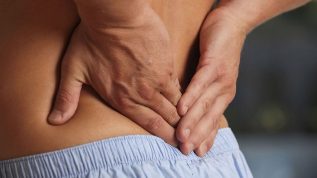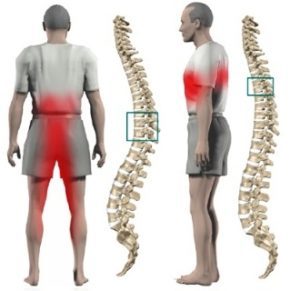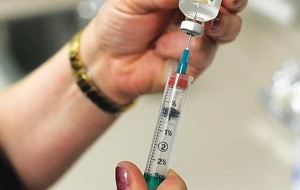Osteochondrosis of the lumbar spine, the symptoms and treatment of which are diverse, is one of the most common pathologies of the musculoskeletal system.
This condition is characterized by the development of degenerative-dystrophic changes in the intervertebral discs, which over time spread to the ligaments and bone tissue of the vertebrae of the lumbosacral spine. An acute process without therapy inevitably becomes a chronic one.
Degenerative diseases can turn a healthy person into a disabled person.
Degree of osteochondrosis of the lumbar spine
Classify 4 degrees of osteochondrosis of the lumbosacral region. The scheme of the development of the disease is as follows:
First degree.In the inner part of the annulus fibrosus, lesions form in the form of tears into which the contents of the nucleus pulposus penetrate and cause irritation. This is the initial stage of osteochondrosis. The deformation of the intervertebral discs is barely pronounced and causes reflex pain with sudden movements and heavy lifting. Unpleasant sensations in the lower spine can be mild and manifest:

- Lumbodynia - local, persistent pain in the lumbar spine;
- Lumbago - sudden painful "lumbago" in the lower back.
Second degree.The destructive processes in the fiber ring continue. The distance from one vertebra to the other decreases, which leads to compression of the nerve fibers. There are discomforts in the lower third of the back that sometimes develop into attacks of pain.
Third degree.During this time, the final destruction of the annulus fibrosus occurs with the extrusion of the nucleus pulposus. Vessels and nerve endings are compressed by intervertebral discs. An intervertebral hernia is formed. The spine is curved and forms:
- Lordosis - arched deformity of the lumbar spine with a forward bulge of the spine;
- kyphosis - the position opposite the lordosis when the arch is formed outward;
- Scoliosis - pathological curvature of the spine to the right or left.
The last degree of osteochondrosisis considered to be the most severe and dangerous. At this point, the spine is already deformed and normal motor activity is lost. X-rays show bony growths in the lumbar spine - the body's response. Pain may be absent for a while, but this does not mean any improvement. People with stage 4 osteochondrosis of the sacro-lumbar spine are often disabled. The reason is that at this stage the process is complicated.
Causes of osteochondrosis of the lumbar spine
The causes of lumbar osteochondrosis include:
- Disproportionate load on the spine.Man is an upright creature, so the load on the spine is considered normal when standing. Performing various actions involves moving, bending, and loosening. To keep the body in the desired state, the musculoskeletal system is in a mode of sustained tension. The load on the spine increases in a sitting position and minimally when lying on your back. When a person is in one position for a long period of time, the lumbar and sacral parts of the spine are overloaded and the muscles do not rest, causing a feeling of discomfort first, and then pain. This deformation factor creates the conditions for the development of osteochondrosis of the lumbar spine.
- Sedentary lifestyle.It contributes to the development of various pathologies, including those that affect the structures of the vertebrae. Sitting for long periods of time leads to deformation of cartilage tissue and a decrease in muscle tone, which leads to the development of lumbar osteochondrosis.
- Excessive physical exertion.Both the lack of vigorous physical activity and its excess do nothing good for the musculoskeletal system. Long, hard work, especially lifting and carrying weights, puts strain on the back muscles and causes vertebral hernias to form.
- Postural disorders.Deformation of the intervertebral discs between the vertebrae can also be caused by improper walking. The reason, in turn, lies in the uneven load on the spine. Intervertebral discs lose elasticity and mobility and are therefore more likely to be damaged. The elderly and the elderly suffer from similar problems more than others.
- bone defects, hereditary pathologies, trauma and infectious lesions.Osteochondrosis is often a consequence of musculoskeletal disorders that occurred during childbirth. For example, when the body's cartilage tissue is naturally fragile. In addition, pathologies of the spine develop after traumatic injuries and processes of infection, such as in osteomyelitis and tuberculosis.
- Flat feet.Signs of a "special" foot are the lack of a notch and the sagging of its arches. Those who have such a trait often face problems with the spine. This is due to the increased stress on the intervertebral discs when walking. Throughout life they are exposed to increased physical stress while moving, so they wear out quickly
- obesity.Obesity is a problem and an additional burden on the body. All organs and systems suffer, including the spine.
- Pathological processes.Functional disorders of various structures can impair the condition of the musculoskeletal system. The factors that cause lumbar spine osteochondrosis are endocrine disorders, cardiovascular problems, and digestive system malfunction.
- Wrong way of life.Many people do not pay enough attention to such simple and important things as physical activity, a balanced diet and normal sleep. An organism that has existed under stressful conditions for a long time becomes weakened and vulnerable. One of the pathologies that can occur on such "fertile" soil is lumbar osteochondrosis.
Symptoms of osteochondrosis of the lumbar spine

Pathological changes in the lumbar spine are expressed in severe symptoms;
- Pain in the lower backis the clearest "signal" for the development of lumbar osteochondrosis. She speaks of the presence of "radicular syndrome" when the compression of the nerve endings of the spine causes pain in the lumbar region. The person becomes tired and irritable. Over time, performing simple and routine activities becomes a major problem due to lower back pain. If an intervertebral hernia has formed in the lumbar region, the pain will spread to the lower leg, the back of the thigh, and the foot. Over time, it becomes more and more difficult to sit and walk. Unpleasant sensations do not let go, even when lying down. Temporary relief may alternate with periods of exacerbation.
- Dysfunction of the genitourinary system.They manifest themselves in pain in the kidney area and frequent urination. A deformation of the intervertebral discs leads to a displacement of the lumbar spine relative to the sacrum. This affects the work of the internal reproductive organs in women and causes problems with potency in men.
- decreased the sensitivity of the legs in the area of the foot.It can be either partial or absolute. At the same time, the reflexes of this part of the body are weakened. Progressive pathology leads to a complete loss of sensitivity of the lower extremities;
- Gait disorders.Lumbar spine pain with osteochondrosis causes a person to deviate when walking in the opposite direction that the nerve fibers are pinched. The condition does not allow walking long distances. A lame person needs to stop from time to time and expect pain relief. Timely medical help can save a person from disability.
Treatment of osteochondrosis of the lumbar spine
Many people wonder whether and how osteochondrosis of the lumbar spine is treated. When the diagnosis is made and the diagnosis is made, the therapeutic tactics are determined.
There are several methods of treating lumbar osteochondrosis. Which of them is necessary and advisable in order to cure a disease or alleviate a person's condition as much as possible is determined by the doctor.
Someone treats himself at home exclusively with folk remedies and forgets that they can only be used with the consent of a specialist and only as part of complex therapy.
Medicines against osteochondrosis
Drug therapy includes the use of:
- tablet forms;
- injection solutions;
- Preparations for external use - ointments and gels.
Drugs are prescribed that remove inflammation and relieve pain in the lumbar spine. They can be used at home.

These can be:
- analgesics;
- nonsteroidal anti-inflammatory drugs;
- Medicines for muscle spasms (muscle relaxants);
- means to restore the cartilage tissue (chondroprotectors);
- Corticosteroids (hormone-containing drugs that relieve pain and inflammation)
- vitamins.
The course of treatment is prescribed by a doctor, who sometimes prescribes pills or potions to calm the nervous system as an additional treatment.
Physiotherapy for lumbar osteochondrosis
Physiotherapy is another common method used to relieve symptoms of lumbar osteochondrosis. It acts on the spine and lower back, improving metabolic and recovery processes.
Most frequently prescribed:
- Magnetic, laser and electrotherapy;
- phonophoresis;
- shock wave method;
- detensor therapy;
- vibration massage;
- balneotherapy.
How many and which procedures are required - the doctor decides.
Physiotherapy is effective in the initial stages of pathology. But, like other types of treatment, it has contraindications. Therefore, when prescribing this method, the doctor takes into account many factors.
Therapeutic gymnastics for lumbar osteochondrosis
A series of physical exercises that can be demonstrated in lumbar osteochondrosis are aimed at restoring the mobility of this spine.
Regularity is seen as the main condition for its effectiveness. Occasional exercises do not have the desired effect.
If the body already has complications from osteochondrosis, this method is not used. In addition, contraindications to its use are severe pathologies of other organs and systems, as well as the presence of pain in the pelvic area and above.
Surgical intervention for osteochondrosis of the lumbar spine
The surgical method is used for serious complications such as an intervertebral hernia. The partial or complete removal of the damaged intervertebral disc (discectomy) is carried out in accordance with the surgical protocol.
The indications for an operation are:
- severe and persistent pain syndrome that cannot be removed with medication for a month;
- the size of the hernia and its effect on the spinal cord.
Osteochondrosis is easier to prevent than cure. Like any pathology, it is potentially dangerous with serious complications. It is important to understand that more or less complete elimination of this pathology is possible in the earliest stages, when the deforming effect on the intervertebral discs is minimal. In other cases, we can only talk about relieving symptoms and maintaining the condition of your body, which will allow you to live and work normally.














































